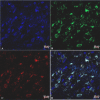Fluorescence In Situ Hybridization (FISH) and Peptide Nucleic Acid Probe-Based FISH for Diagnosis of Q Fever Endocarditis and Vascular Infections
- PMID: 29899006
- PMCID: PMC6113452
- DOI: 10.1128/JCM.00542-18
Fluorescence In Situ Hybridization (FISH) and Peptide Nucleic Acid Probe-Based FISH for Diagnosis of Q Fever Endocarditis and Vascular Infections
Retraction in
-
Retraction for Prudent et al., "Fluorescence In Situ Hybridization (FISH) and Peptide Nucleic Acid Probe-Based FISH for Diagnosis of Q Fever Endocarditis and Vascular Infections".J Clin Microbiol. 2024 Feb 14;62(2):e0150823. doi: 10.1128/jcm.01508-23. Epub 2024 Jan 4. J Clin Microbiol. 2024. PMID: 38174947 Free PMC article. No abstract available.
Expression of concern in
-
Expression of Concern for Prudent et al., "Fluorescence In Situ Hybridization (FISH) and Peptide Nucleic Acid Probe-Based FISH for Diagnosis of Q Fever Endocarditis and Vascular Infections".J Clin Microbiol. 2022 Oct 19;60(10):e0107722. doi: 10.1128/jcm.01077-22. Epub 2022 Sep 7. J Clin Microbiol. 2022. PMID: 36069599 Free PMC article. No abstract available.
Abstract
Endocarditis and vascular infections are common manifestations of persistent localized infection due to Coxiella burnetii, and recently, fluorescence in situ hybridization (FISH) was proposed as an alternative tool for their diagnosis. In this study, we evaluated the efficiency of FISH in a series of valve and vascular samples infected by C. burnetii We tested 23 C. burnetii-positive valves and thrombus samples obtained from patients with Q fever endocarditis. Seven aneurysms and thrombus specimens were retrieved from patients with Q fever vascular infections. Samples were analyzed by culture, immunochemistry, and FISH with oligonucleotide and PNA probes targeting C. burnetii-specific 16S rRNA sequences. The immunohistochemical analysis was positive for five (17%) samples with significantly more copies of C. burnetii DNA than the negative ones (P = 0.02). FISH was positive for 13 (43%) samples and presented 43% and 40% sensitivity compared to that for quantitative PCR (qPCR) and culture, respectively. PNA FISH detected C. burnetii in 18 (60%) samples and presented 60% and 55% sensitivity compared to that for qPCR and culture, respectively. Immunohistochemistry had 38% and 28% sensitivity compared to that for FISH and PNA FISH, respectively. Samples found positive by both immunohistochemistry and PNA FISH contained significantly more copies of C. burnetii DNA than the negative ones (P = 0.03). Finally, PNA FISH was more sensitive than FISH (60% versus 43%, respectively) for the detection of C. burnetii We provide evidence that PNA FISH and FISH are important assays for the diagnosis of C. burnetii endocarditis and vascular infections.
Keywords: Coxiella burnetii; FISH; PNA probe; Q fever; infective endocarditis; oligonucleotide probe; vascular infections.
Copyright © 2018 American Society for Microbiology.
Figures





Similar articles
-
Molecular detection of Coxiella burnetii in the sera of patients with Q fever endocarditis or vascular infection.J Clin Microbiol. 2004 Nov;42(11):4919-24. doi: 10.1128/JCM.42.11.4919-4924.2004. J Clin Microbiol. 2004. PMID: 15528674 Free PMC article.
-
Detection of Coxiella burnetii in heart valve sections by fluorescence in situ hybridization.J Med Microbiol. 2018 Apr;67(4):537-542. doi: 10.1099/jmm.0.000704. Epub 2018 Feb 20. J Med Microbiol. 2018. PMID: 29461187
-
Molecular diagnosis of Coxiella burnetii in culture negative endocarditis and vascular infection in South Korea.Ann Med. 2021 Dec;53(1):2256-2265. doi: 10.1080/07853890.2021.2005821. Ann Med. 2021. PMID: 34809520 Free PMC article.
-
Q fever endocarditis.Eur Heart J. 1995 Apr;16 Suppl B:19-23. doi: 10.1093/eurheartj/16.suppl_b.19. Eur Heart J. 1995. PMID: 7671918 Review.
-
A contemporary 16-year review of Coxiella burnetii infective endocarditis in a tertiary cardiac center in Queensland, Australia.Infect Dis (Lond). 2018 Jul;50(7):531-538. doi: 10.1080/23744235.2018.1445279. Epub 2018 Mar 8. Infect Dis (Lond). 2018. PMID: 29516748 Review.
Cited by
-
Contemporary diagnostics for medically relevant fastidious microorganisms belonging to the genera Anaplasma,Bartonella,Coxiella,OrientiaandRickettsia.FEMS Microbiol Rev. 2022 Jul 20;46(4):fuac013. doi: 10.1093/femsre/fuac013. FEMS Microbiol Rev. 2022. PMID: 35175353 Free PMC article.
-
Visualization of Gene Reciprocity among Lactic Acid Bacteria in Yogurt by RNase H-Assisted Rolling Circle Amplification-Fluorescence In Situ Hybridization.Microorganisms. 2021 Jun 3;9(6):1208. doi: 10.3390/microorganisms9061208. Microorganisms. 2021. PMID: 34204984 Free PMC article.
-
Native valve, prosthetic valve, and cardiac device-related infective endocarditis: A review and update on current innovative diagnostic and therapeutic strategies.Front Cell Dev Biol. 2022 Oct 3;10:995508. doi: 10.3389/fcell.2022.995508. eCollection 2022. Front Cell Dev Biol. 2022. PMID: 36263017 Free PMC article. Review.
-
Coxiella burnetii Pathogenesis: Emphasizing the Role of the Autophagic Pathway.Arch Razi Inst. 2023 Jun 30;78(3):785-796. doi: 10.22092/ARI.2023.361161.2636. eCollection 2023 Jun. Arch Razi Inst. 2023. PMID: 38028822 Free PMC article. Review.
-
Quality Control in Diagnostic Fluorescence In Situ Hybridization (FISH) in Microbiology.Methods Mol Biol. 2021;2246:301-316. doi: 10.1007/978-1-0716-1115-9_20. Methods Mol Biol. 2021. PMID: 33576998
References
-
- Botelho-Nevers E, Fournier P-E, Richet H, Fenollar F, Lepidi H, Foucault C, Branchereau A, Piquet P, Maurin M, Raoult D. 2007. Coxiella burnetii infection of aortic aneurysms or vascular grafts: report of 30 new cases and evaluation of outcome. Eur J Clin Microbiol Infect Dis 26:635–640. doi:10.1007/s10096-007-0357-6. - DOI - PubMed
Publication types
MeSH terms
Substances
LinkOut - more resources
Full Text Sources
Other Literature Sources
Medical

